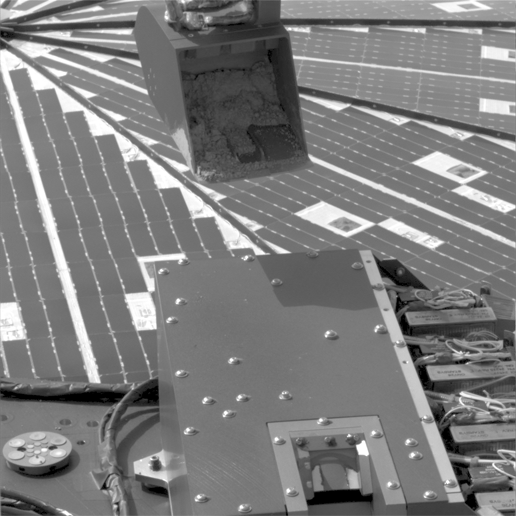Successful Sprinkle
The Phoenix Mars Lander used its Robotic Arm during the mission’s 15th Martian sol to test the “sprinkling” method for delivering small samples of soil to instruments on the lander deck. The “movie” shown here is a sequence of four images from the spacecraft’s Surface Stereo Imager, and demonstrates the actions of Phoenix for a 20 minute period. The sprinkling was tested because a couple of days ago, the first attempt at bringing soil samples to the scientific instruments was unsuccessful. The soil, when just dumped as a whole onto Phoenix’s deck, clumped together and wouldn’t go through a screen that brings the materials to the TEGA instrument to analyze the soil. The sprinkling technique, by contrast, holds the scoop at a steady angle and vibrates the scoop by running the motorized rasp located beneath the scoop. This gently jostles some material out of the scoop to the target below.
This method seems to distribute the material better, and “unclumps” the frozen clods of soil. For this test, the target was near the upper end the cover of the Microscopy, Electrochemistry and Conductivity Analyzer instrument suite, or MECA. The cover is 20 centimeters (7.9 inches) across. The scoop is about 8.5 centimeters (3.3 inches) across.
Based on the test’s success in delivering a small quantity and fine-size particles, the Phoenix team plans to use the sprinkle method for delivering more samples to MECA and then to the Thermal and Evolved-Gas Analyzer, or TEGA. The delivery to MECA’s Optical Microscope, will be via the port in the MECA cover, visible at the bottom of the image.
Meanwhile, Phoenix will continue a set of atmospheric observation begun during the Martian evening on Tuesday in coordination with overhead passes of NASA’s Mars Reconnaissance Orbiter. These take advantage of opportunities for instruments on Phoenix and on the orbiter to examine the same column of atmosphere simultaneously from above and below.
“It allows us to put the Phoenix measurements into global perspective and gives a ground level calibration for the orbiter’s measurements,” said Phoenix Project Scientist Leslie Tamppari of the Jet Propulsion Laboratory.
Source: Phoenix News


One question: By what method do they clean up the extra stuff that gets piled up on top of the deck and the instrument hatches? Surely there must be some way?…
Please tell me those cables are tied together with duct tape.
I want to see it sprinkle water ice.. 🙁
Maids on MARS!!!
Every time I read something like this its like having to learn to tie your shoes again. Everything becomes so much more difficult remotely controlling something millions of miles away, and having to think about the consequences of each action before you do it.
Does anyone of you know if the spectrometer ovens are reusable? Can they be emptied, cleaned up, and used for another sample? From what I hear it looks like it is not the case, and that they have only eight attempts (one for each of the eight cells) to analyze samples. Well, now only seven, but hopefully at least the second sample gets baken and analyzed).
Don’t get me wrong – I think the people who put Phoenix on Mars are doing a great job. But it seems kind of sloppy to be sprinkling dirt all over the lander, sensitive equipment and possibly the solar panels. Wasn’t there a better place to practice sprinkling samples? Like on the landing feet, maybe?
“# trux Says:
June 11th, 2008 at 1:50 pm
Does anyone of you know if the spectrometer ovens are reusable? Can they be emptied, cleaned up, and used for another sample? From what I hear it looks like it is not the case, and that they have only eight attempts (one for each of the eight cells) to analyze samples. Well, now only seven, but hopefully at least the second sample gets baken and analyzed).”
I was wondering that too, and I think that you are probably correct – the ovens are once only and they have 8 shots. If that is the case, I guess the case can be made that a) the mission is nominally going for not much over 90 days so there’s no point in including capability for much more than 8 ‘bakes’, and b) the robotic arm can reach to a limited radius only, so if they choose their samples carefully with solid scientific justification then 8 samples should be able to provide fairly good coverage.
Having said that, if it is the case that they are ‘use once’, then they seriously stuffed up by not attempting a ‘sprinkling’ of the sample before just dumping it on the first oven port and hoping all went well…
I was asking the same thing to myself. In addition, what is NASA’s solution to dust collecting on the solar panels over time? It seems to me that some simple wiper blades of some kind could extend the mission life dramatically.
The ovens are NOT reusable. We get 8 chances.
Hee hee…Phoenix soiled itself…